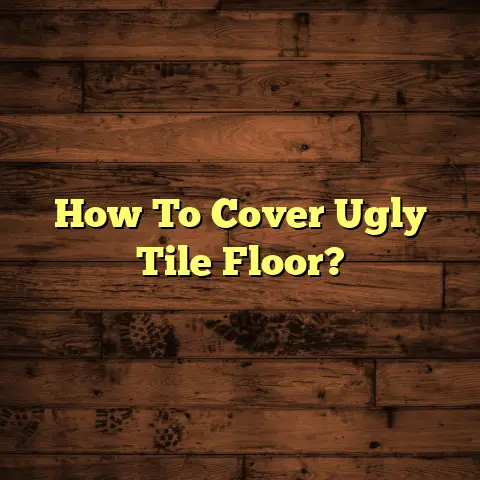Screen & Recoat Hardwood Floors? (3 Steps To Pro Finish!)
From pet stains that look like abstract art to scratches deep enough to tell a story, I’ve tackled every kind of flooring woe you can imagine.
But one thing I’ve learned is that you don’t always need a full-blown sanding and refinishing to bring your hardwood floors back to life.
Sometimes, all they need is a little love – and a good screen and recoat.
Hardwood flooring is more than just a practical choice; it’s an investment in the beauty and warmth of your home.
Think about it: the rich tones, the natural grain patterns, the way the light dances across the surface.
It’s like having a piece of art right under your feet!
But like any piece of art, hardwood floors require regular maintenance to keep them looking their best.
That’s where the screen and recoat process comes in.
It’s a fantastic way to refresh your floors, protect them from further wear and tear, and add years to their lifespan.
And the best part? With a little bit of elbow grease and the right know-how, you can achieve a professional finish yourself!
I’m going to walk you through the entire process, step by step, so you can bring that showroom shine back to your floors.
Ready to get started? Let’s dive in!
Section 1: Understanding the Screen & Recoat Process
So, what exactly is a screen and recoat?
In simple terms, it’s a process of lightly abrading the existing finish on your hardwood floor and then applying a new coat of finish on top.
Think of it like giving your floors a facial – a gentle exfoliation followed by a nourishing treatment.
It’s not a full refinishing, which involves sanding down to the bare wood, but it’s a great way to revive floors that are showing signs of wear but aren’t severely damaged.
Here’s why I recommend screen and recoat for many of my clients:
-
Cost-Effective:
- It’s significantly cheaper than a full refinishing, often costing just a fraction of the price.
-
Time-Efficient:
- The entire process can usually be completed in a day or two, minimizing disruption to your home.
-
Minimal Disruption:
- Unlike sanding, screening creates very little dust, making cleanup a breeze.
-
Preserves the Wood:
- It doesn’t remove any of the existing wood, so you’re preserving the character and history of your floors.
I’ve seen homeowners save thousands of dollars by opting for a screen and recoat instead of a full refinish.
According to a recent survey by the National Wood Flooring Association (NWFA), the average cost of a full refinish is around \$5-\$8 per square foot, while a screen and recoat typically costs only \$1-\$3 per square foot [Source: NWFA Cost Survey, 2023].
That’s a significant difference!
But is screen and recoat right for your floors?
Here’s the key: it’s best suited for floors with light surface scratches, scuffs, and dullness.
If your floors have deep gouges, water damage, or areas where the finish has completely worn away, a full refinishing might be necessary.
Think of it this way: if you can live with the imperfections after a good cleaning, a screen and recoat is probably a good option.
But if those imperfections are driving you crazy, it’s time to bring out the big guns (i.e., the sander).
Pro Tip: A simple test I often recommend is the “water drop test.” Place a few drops of water on different areas of your floor. If the water beads up, your finish is still intact. But if the water soaks in, it’s time for some maintenance.
Section 2: Step-by-Step Guide to Screen & Recoat
Alright, let’s get down to the nitty-gritty.
Here’s a detailed, step-by-step guide to screen and recoating your hardwood floors like a pro.
1. Preparation: The Key to Success
Trust me, preparation is everything when it comes to flooring.
It’s like baking a cake – if you don’t have all your ingredients measured and ready to go, the whole thing can fall apart.
-
Clear the Room:
- Remove all furniture, rugs, and anything else that’s on the floor. This includes curtains and wall hangings, as dust can settle on them during the process.
-
Thorough Cleaning:
- This is where you need to channel your inner clean freak. Start by vacuuming the entire floor thoroughly, paying special attention to corners and edges.
- Then, use a hardwood floor cleaner and a microfiber mop to remove any dirt, grime, or residue.
- I’m a big fan of Bona Hardwood Floor Cleaner, but there are many other great options out there. Just make sure it’s specifically designed for hardwood floors.
- For stubborn spots, you can use a slightly damp cloth and a gentle cleaner. Avoid using harsh chemicals or abrasive cleaners, as they can damage the finish.
- Pro Tip: Before you start cleaning, take a close look at your floor. Are there any areas with wax buildup? If so, you’ll need to remove the wax before you can screen and recoat. Mineral spirits and a soft cloth usually do the trick.
-
Assess the Floor’s Condition:
- Now that the floor is clean, take a good hard look at it. Are there any areas with deep scratches or gouges? Are there any signs of water damage?
- As I mentioned earlier, if the damage is extensive, a full refinishing might be necessary. But if it’s just surface wear and tear, you’re good to go with a screen and recoat.
- Pro Tip: Pay close attention to high-traffic areas, like hallways and doorways. These areas tend to show wear and tear more quickly.
2. Screening: The Gentle Abrasion
Now comes the fun part – the screening! This is where you’ll lightly abrade the existing finish to create a surface that the new finish can adhere to.
-
Gather Your Tools:
- You’ll need a floor buffer (which you can rent from most hardware stores), a screening pad (usually made of nylon or mesh), and some safety glasses and a dust mask.
- The grit of the screening pad is important. I generally recommend using a 120-grit or 150-grit screen for most floors. A higher grit is finer and will create a smoother surface, while a lower grit is coarser and will remove more of the finish.
- If you’re not sure which grit to use, start with the higher grit and see how it goes. You can always switch to a lower grit if needed.
-
Prepare the Buffer:
- Attach the screening pad to the floor buffer according to the manufacturer’s instructions. Make sure it’s securely attached, as you don’t want it flying off in the middle of the process!
-
Screen the Floor:
- Put on your safety glasses and dust mask. Start the buffer and begin screening the floor in a slow, overlapping pattern.
- Don’t apply too much pressure – let the weight of the machine do the work.
- Keep the buffer moving at a steady pace. If you stay in one spot for too long, you can damage the finish.
- Pay special attention to edges and corners. You can use an edge sander or a hand-held sanding block to reach these areas.
- Pro Tip: I like to use a shop vac to suck up the dust as I go. This helps to keep the air clean and prevents the dust from settling back onto the floor.
-
Clean Up:
- Once you’ve screened the entire floor, vacuum it thoroughly to remove all the dust. Then, use a tack cloth to wipe down the floor and remove any remaining dust particles.
- A tack cloth is a sticky cloth that’s designed to pick up dust and debris. You can find them at most hardware stores.
3. Recoating: The Finishing Touch
You’ve made it to the final step – the recoating! This is where you’ll apply a new coat of finish to your floors, bringing them back to their former glory.
-
Choose Your Finish:
- There are two main types of finishes: water-based and oil-based. Both have their pros and cons.
- Water-based finishes are low in VOCs (volatile organic compounds), which means they’re more environmentally friendly and have less odor. They also dry faster than oil-based finishes and tend to be clearer, which means they won’t yellow over time.
- Oil-based finishes are more durable than water-based finishes and tend to have a richer, warmer tone. However, they have higher VOCs, which means they have a stronger odor and take longer to dry.
- I personally prefer water-based finishes for most residential applications. They’re durable enough for everyday wear and tear, and I appreciate their low-VOC properties.
- According to the EPA, choosing low-VOC products can significantly improve indoor air quality [Source: EPA Indoor Air Quality].
- Pro Tip: If you’re not sure which finish to choose, talk to a flooring professional. They can help you select the best finish for your needs and budget.
- There are two main types of finishes: water-based and oil-based. Both have their pros and cons.
-
Gather Your Supplies:
- You’ll need your chosen finish, an applicator (such as a lambswool applicator or a T-bar applicator), a paint tray, and some painter’s tape.
-
Prepare the Area:
- Tape off any areas that you don’t want to get finish on, such as baseboards and door frames.
- Make sure the room is well-ventilated. Open windows and doors, and use fans to circulate the air.
-
Apply the Finish:
- Pour some of the finish into the paint tray. Dip the applicator into the finish and apply it to the floor in a smooth, even coat.
- Work in small sections, overlapping each pass slightly.
- Don’t apply too much finish at once. It’s better to apply several thin coats than one thick coat.
- Follow the manufacturer’s instructions for drying times. Most finishes require at least 24 hours to dry completely.
- Pro Tip: I like to use a technique called “feathering” to blend the edges of each section. This helps to create a seamless finish.
-
Apply Additional Coats (If Needed):
- Depending on the type of finish you’re using, you may need to apply multiple coats. Follow the manufacturer’s instructions for the number of coats and the drying time between coats.
- Before applying each coat, lightly screen the floor with a fine-grit screening pad (220-grit or higher) to create a smooth surface for the new coat to adhere to.
-
Cure Time:
- Once the final coat has dried, allow the finish to cure for the recommended amount of time. This can take several days or even weeks, depending on the type of finish.
- During the curing process, avoid walking on the floor in socks as they can leave marks.
- Pro Tip: Patience is key here! Don’t rush the curing process, or you could end up with a damaged finish.
Section 3: Aftercare and Maintenance
Congratulations! You’ve successfully screened and recoated your hardwood floors. Now, it’s time to keep them looking their best.
Here are some tips for aftercare and maintenance:
-
Regular Cleaning:
- Sweep or vacuum your floors regularly to remove dirt and debris. Use a microfiber mop and a hardwood floor cleaner to clean your floors as needed.
- Avoid using harsh chemicals or abrasive cleaners.
- Pro Tip: Place mats at entrances to trap dirt and debris before they get onto your floors.
-
Recommended Products:
- I’m a big fan of Bona Hardwood Floor Cleaner, but there are many other great options out there. Look for cleaners that are specifically designed for hardwood floors and that are pH-neutral.
-
Humidity Control:
- Hardwood floors are sensitive to humidity. High humidity can cause the wood to swell, while low humidity can cause it to shrink.
- Maintain a consistent humidity level in your home to prevent damage to your floors.
- I recommend using a humidifier or dehumidifier to control the humidity levels. The ideal range is between 30% and 50%.
-
Protect Your Floors:
- Use felt pads under furniture legs to prevent scratches. Avoid wearing shoes with high heels or cleats on your floors.
- Clean up spills immediately to prevent staining.
-
Repeat the Process:
- Depending on the amount of traffic your floors receive, you may need to repeat the screen and recoat process every few years.
- I generally recommend doing it every 3-5 years to keep your floors looking their best.
Conclusion
Maintaining hardwood floors is an art, a craft, and a commitment to preserving the beauty of your home.
I truly believe that with the right knowledge and a little effort, anyone can achieve a professional finish.
The screen and recoat process is a fantastic way to refresh your floors, protect them from wear and tear, and add years to their lifespan.
So, go ahead, take pride in your floors and enjoy the satisfaction of a job well done.
Remember, your floors are more than just something you walk on – they’re a reflection of your style, your taste, and your commitment to creating a beautiful and inviting home.
And who knows, maybe you’ll even discover a hidden talent for flooring along the way!
Happy Flooring!





